Wow! What an exciting morning! We had a team of brain scientists come and explain their work to us. We learned lots, and fed our enthusiasm for science.
What did you learn?
What are the parts of the brain and what are they used for?
What did you see and do?
How will today inspire you in future?
What philosophical issues did you come across?
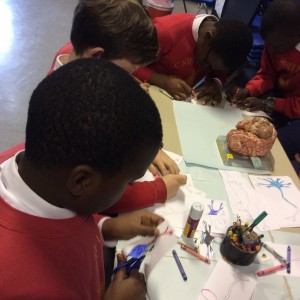
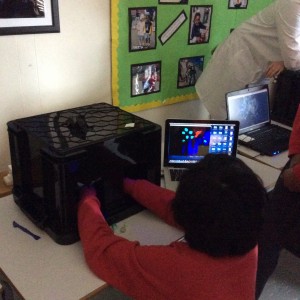

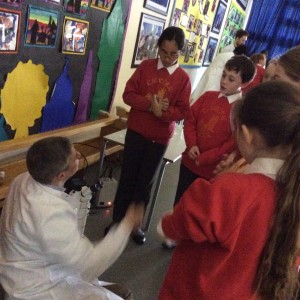
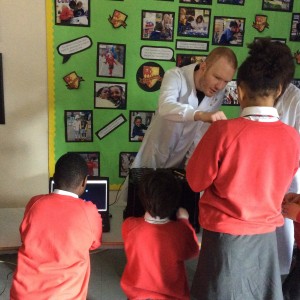
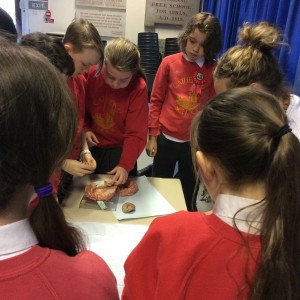
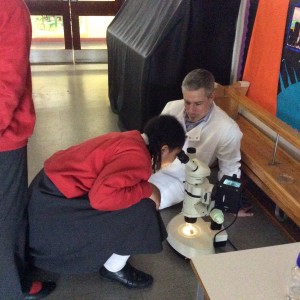

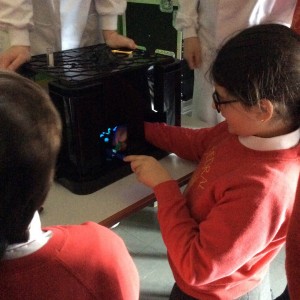


16/03/16
The Visit from the Scientists
After break time, the whole of class 6 went into the hall to do and learn some science. When we first went inside we saw the room had no lights on and all of the curtains were pulled across the windows to make sure barely any light was getting into the room; this was because the main part of the session was about glowing in the dark.
My group – which consisted of 7 people – first of all went to learn about the brain and what was inside is, what different parts did and what the names of those parts were. This was a really fun part because we got to learn all about the real brain just from looking at a model and we got to hear an amazing (true) story about a man who survived a serious brain injury.
The Story:
A long time ago, a very kind, generous, helpful man worked at a mine-cart rail selling sticks of dynamite, (WARNING! The next part is a bit disgusting!) Then one day a pole went right through his eye and out of the top of his head and took away part of his brain that controlled his personality. Luckily, he survived however, his personality completely changed and he was a mean, horrible, nasty person.
That story really made us all go, “Ew!” and we definitely learnt a lot from it.
We did many other experiments including:
Brain Surgery (fake)
Looking at glow in the dark animals through a microscope
Seeing which household objects would and wouldn’t glow in the dark.
Now I have been inspired to be: either a surgeon or a vet.
What I learnt:
I learnt all about the different ways to make animals glow in the dark, this doesn’t work on all animals but it works on the zebra fish: you have to get the glow gene from a jelly-fish and insert it into the zebra fish to make it glow. I also learnt how to do surgery on a brain, we used a large model of a mouse’s brain and we had fluorescent play dough inside (which we referred to as bad cells) and, using a plastic scalpel, we had to remove them from the brain.
What are the parts of the brain and what are they used for?:
There are many different parts of the brain and they all play an important part in your body; we learnt all about these and looked closely at the model.
There is:
Frontal Lobe – This controls your personality and that was what got pulled out of the man’s head in the story I told you above.
Motor Cortex – This controls the way you move
Parietal Lobe – This gives you understanding, it makes sense of the world and also controls your arithmetic and spelling.
Temporal Lobe – Memory and language
There are many more but these are the main ones we learnt.
How will today inspire you in the future?:
Today has inspired me because I learnt how to do many things that I would have never thought of doing even in secondary school and I now know how to do surgery on a brain and how hard it is! I also know how to make experiments easier by using ultra-violet light and genes that glow in the dark. I now know that it would be hard to do this job but that has inspired me more to do it because we have been given a great opportunity and it would be a shame to waist all the information that we have learnt.
I enjoyed going to the science workshop today because it was really fun learning about the brain and how the scientists experiment on them. They use jellyfishes’ jeans to make the brain glow so they can see what they are doing. The brain scientists look at the computer instead of looking at the brain, it is harder but worth it.
There are many different parts of the brain: the crinkly part that protects the actual brain on top is called the cortex and the long bone that connects to your spinal cord is called the brain stem. The part behind your ear is called the cerebellum and there are two of them; one to help you hear and one to control your balance and put sentences together.
We had discussions about how people would give up their bodies to the brain scientist and other scientist to experiment on after they had died. That could be very useful for discovering something new.
I learnt so many new things today that will come in handy as I would like to take on the job of what the surgeons taught us today.
I have learnt a lot about the brain and how it develops, I also learnt about how a fruit fly develops. The brain stem (which is in the middle of the brain) controls your breathing, your temperature and many more body functions. Fruit flies like to eat, and when they are babies they eat all day. When they grow up they don’t move around that much because they are developing. It inspires me to find out more and go into further research about it.
What did you learn? What are the parts of the brain and what are they used for?
I learnt that the crinkly bit at the back of our heads is the cortex and that controls our movement and the way we breathe. I also learnt that the frontal cortex controls our emotions and it builds our personality but it also controls our memory so it helps us remember our name, how to write and what our favourite food is. Our brain stem is at the centre of the brain and is linked with the spinal cord (spine) so it controls our nerve system.
How will today inspire you?
I want to become a doctor when I’m older so I already know about the brain and now I can focus on other parts of the human body.
What philosophical issues did you come across?
What is more important the heart or the brain, they are equal because your brain tells everything what to do and your heart takes in the oxygen for you to live.
What did you see and do?
We saw animals that glowed in the dark and items that we use everyday glow. We also saved a mouse’s brain (it was fake) by taking out bad things from it. Also we looked at the parts of the brain and how they work- if you want to know the parts of the brain look at the first paragraph/question again.
Today we learnt all about the brain and what is inside your brain. If you were born without a heart you can get a heart transplant. Our brain controls most of our actions and what we do, how we breathe, our balance and many more things. The human brain is like a powerful computer that stores our memory and controls how we as humans think and react. The human brain is the most complex organ in the human body and probably the most complex creation present in this universe. And the lack of oxygen in the brain for 5 to 10 minutes results in permanent brain damage
What did you learn from the experience?
I learnt that being a scientist is hard because when you study the brain, there are many different jobs to do, such as:
Dissecting, studying and learning; observing and more! Also, I learnt that your brain is not a massive lump, even though it is squishy- it has many parts to it and is made of around ten billion neurons (nerve cells).
What particularly did you enjoy? Why?
I enjoyed looking through the microscope because it is interesting to look through it and see what almost looks invisible to the naked eye… and alive!! I enjoyed the whole session and I want to do it again if I could. Thank you.
Did you come across any philosophical questions?
While we were looking at the different parts of our brain, I thought about if the brain was more important than the heart. I thought about it but after a while I came to this hypothesis: without the brain, we would die. What would control our breathing? Without the brain however, we would also die because we would suffer from lack of oxygen and blood. So, they are both equally important!
1. What do we need more our brain or our heart?
Both are really important to us in life, if we had no brain we would not be controlled and if we had no heart we would have no oxygen. But in my opinion I think the brain; I used to think the heart because we would not be able to breathe but then I learnt that the brain controls the heart and oxygen and also controls if you would want to eat or drink.
DID YOU KNOW THAT OUR BRAIN HAS A BONE?
2. What is the bone in our brain?
The bone in our brain is called the brain stem and it controls what you want to eat drink and controls your memory it is right in the middle with a point with the skull protecting it.
What did you learn from the experience?
I learnt that being a scientist is hard because when you study the brain, there are many different jobs to do, such as:
Dissecting, studying and learning; observing and more! Also, I learnt that your brain is not a massive lump, even though it is squishy- it has many parts to it and is made of around ten billion neurons (nerve cells).
What particularly did you enjoy? Why?
I enjoyed looking through the microscope because it is interesting to look through it and see what almost looks invisible to the naked eye… and alive!! I enjoyed the whole session and I want to do it again if I could. Thank you.
Did you come across any philosophical questions?
While we were looking at the different parts of our brain, I thought about if the brain was more important than the heart. I thought about it but after a while I came to this hypothesis: without the brain, we would die. What would control our breathing? Without the heart however, we would also die because we would suffer from lack of oxygen and blood. So, they are both equally important!
Did you come across any philosophical issues?
Yes, people were stating their opinion on what was more important the heart or the brain? I initially said that the heart was more important, but after learning more about the brain I think the brain is more important. If you are born without a heart you can get a heart transplant. Our brain controls most of what we do, how we breathe, our balance and lots more. If we had no brain we would not be able to walk, this is because our brains’ stem controls our balance, his would be so hard it would feel like you are walking on one leg. Without a brain we would not be able to see because there would be no light to process. Without a brain you would be in a very severe condition, machines would be controlling your breathing. No brain leads to other problems like blindness. This is why I think the brain is more important. What do you think is more important?
I have learnt that the bone in the middle of your brain is called your Brain Stem. One of this most philosophical question that I came across was the question, would you give away your body after you die in the name of science? I think that I would because with your body, scientists and doctors can find cures to some diseases in the world. I saw embryos of fruit flies and zebra fish, they were so small that we had to use a microscope to look at them and they were fascinating. The embryos of the fruit flies were little maggots and you could see them crawling around whereas, the embryos of the zebra fish could glow in the dark when put under a UV ray, they glowed a bright green but were a bit hard to see as they were so small. I have always wanted to be a doctor, as my dad is a nurse, but after coming in today I think that I might want to be a neurosurgeon as it is very interesting, so I found this workshop life-changing.
The visit for the scientists
After break time all of Class 6 went to the hall to learn more about science. We broke into 4 groups of 7 and went to different places: like looking into a microscope to see a zebra fish as a cell, a chick cell and a fruit fly cell. When we focused on one, we could see that the fruit fly cell is actually moving (it was quite disgusting). In another place we saw how a rat’s brain would be (very small).
We played this game where there’s this box where we have to take out a rat’s brain out of the box gently (the brain was not real just playdo) and we all take turns each. Next we went to a table where we learn which part of our brain is. We’d colored in a cell with a crayon. We got to see different kind of kitchen stuff if it would glow in the dark or it would not glow in the dark. At the end we put a smiley face onto see if we liked it or put the smiley face upside down if we didn’t like it at all.
Today, at the science visit, I learnt some amazing things, we were visited by some scientists from Kings University, these scientists were brain researchers, to study the brain, it is easier to have it light up, so, from jellyfish extracts, and a scientist made a substance that glows in the dark. We [class 6] tried some experiments, by looking at a computer we pulled play dough cells from a model mouse brain, it was a lot of fun! We came to think at the next activity what is more important, the brain or the heart? I came to a conclusion that the brain is more important, because you could always get a machine to pump your heart for you whereas the brain is impossible to replace, in that same activity we learn about the cortex, a part of the brain that controls breathing, blinking and your memory. In the next session we had a look at glowing zebra fish and maggots, though the maggots were covered in their food, we also, in the next activity we had a look at things you would have in your house that would glow, my group came to a final decision that white glowed the most- oh, and Vaseline. I enjoyed it so much, thank you for this.
What did you learn?
I learnt that different things you use at home glow such as: baby power, glow bands, oil, ginger and many more; I saw what it was like using a microscope and I saw maggots, using the microscope. I saw a rat’s brain and had a go taking out some of the glowing playdo which was stuck in a fake model of a rats brain.
How will today inspire you in future?
It will kind of change my mind and become a scientist because now I know what they do and how they do it.
Our Science Lesson
What did you learn?
We learnt more about science like: what is in the middle of your brain? The thing that in in the middle of our brain is called the brain stem. And what is over it, it is called cortex. Cortex- the outer layer of the cerebrum (the cerebral Cortex), composed of folded grey matter and playing an important role in consciousness.
What did you do?
We used a plastic scapulae to dissect fake cells (made of glow in the dark play do) from a fake rat- it was really fun I recommend you to do it if you get the chance.
What philosophical issues did you come across?
Well one of the scientist asked me, what do you think is more important the brain or the heart. I said some thing like If your brain stops you are dead, no intervention is possible and there is no way to transplant a new brain into a person. The brain, and specifically your brain, is more important to being alive than your heart is.
I have learnt a lot about the brain and how it develops, I also learnt about how a fruit fly develops. The brain stem (which is in the middle of the brain) controls your breathing, your temperature and many more body functions.Fruit flies like to eat, and when they are babies they eat all day.When they grow up they don’t move around that much because they are developing. It inspires me to find out more and go into further research about it. In the lesson we got to see how scientists study the human brain and we got to have a look through the machine that makes thing bigger,we saw the zebrafish glow in the dark.
I really enjoyed today our science lesson by the people at Kings Collage. We got to see what goes on in your brain and what they are called and deceit a modal of a mouse’s brain. I liked seeing what happens when you put the bit that glows of a jellyfish and put it into a zebra fish. Unfortunately as I have very big eyelashes It was hard to see some of the zebra fish glow through the microscope as my eyelashes got in the way. We also as well got to see which ordinary kitchen items would glow in the dark. Here are some of the things that glowed:
. A tube of toothpaste. (This worked because of its micro crystals inside it).
. A glow stick. (Surprisingly the sticks that glowed didn’t glow and the ones that didn’t glow did).
. Soap powder. (The soap had little miniature crystals in it too so it glowed as well).
. George’s watch. (Because George’s watch had something inside it, this glowed too!)
I was mostly really fascinated by the brain. Here is a fun fact for kids, before the age of around 25, our brain weighs a whopping 10kg! That’s more than 3 dictionaries! Before I came here, I didn’t know anything about it but now I do. I’ve got a couple of question for the people that work on the brain and the body.
What is your favorite bit of the brain and why is it you’re favorite?
In the whole world, which animal do you think has the smallest brain?
What’s the hardest brain you have ever worked on and why?
I have learnt such a lot today and had a lot of fun. Thank you Ester and the amazing scientists that came today from Kings Collage. You are all excellent at science!
What did you learn in Science?
The substance that makes the brain cell glow in the dark is from a jelly-fish. I now know the parts of the brain: Cortex[the tissue], Brain stem[which makes the spinal cord move], Cerebellum[at the back the skull, which controls muscle activity] and I know where they are. When doing brain surgery the scientists would look at a computer to show them where the brain cells are. The brain and the heart are both important as each other. The brain has about 10 million neurons. Our brain weighs up to 3 pounds, and we are born out of an egg. Now I want to be a brain surgeon and collect the brain cells.
Today I really enjoyed our science lesson led by scientists from King’s College. I learnt how to disect a mouse brain and luckily got to see tiny glow in the dark zebrafish (they are called this because they have stripes on them just like zebras). Also we made household items glow, these objects were: toothpaste, my watch, Vaseline, glow sticks (surprisingly the one that didn’t glow were the ones already glowing, and the one that weren’t glowing glowed). We also learnt the parts of the brain the most important bit was the spinal cord: it connects all your nerves to all different places around your body. My favourite part was using ordinary kitchen items glow in the dark. A really cool fact I learnt today was before the age of 25 your brain was 10kg almost that’s about as heavy as two bags of sugar.
Which is more important the brain or the heart?
Well after knowing all this I would say the brain, because it creates your personality, helps you hear, see and talk. Well as your heart just keeps you alive so does your brain it’s connected to all parts of your body even you heart. So now do you understand what I mean?
I really enjoyed today and would love to say another thank you for coming in and gave a really big smiley face!
Today King College Neurology Scientist came to teach us about the brain and how they dissect the brain like surgeons. What they do is the put chemicals on the brain so they can see all the different part and then they pick them out and work on them. We also got to use different household materials and put them under a florescent light and we would see if they glow – if the object was white it worked better- . I found out that if a glow stick that does not have a glow outside of the box when it enters the box it starts to turn into a bright colour.
Then we went to a scale model of a mouse’s brain and it had holes in it where they put in glow plastecine and using the computer camera you had to use a plastic scalper to pick them out and we got a minor experience on what surgeon would do on a daily basis. We moved to see a model of the brain and one o the scientist came and taught us the part of the brain like the cerebellum which helps with coordination and balance ,the brain stem which connects to the spinal cord ,the occipital lobe is the visual procession center of the brain and many more .
I really enjoyed getting to learn more about the brain and it made me want to be a brain surgeon or neurologist as I would like to work on the neurons in the brain as I could learn more about the body and might make something new in the science world .
What did you learn?
I learnt what the crinkly bit of your brain is called, it’s called the cortex and it sits under your ear.
I also learnt that there are lots of different parts to a brain, there’s the cortex, the brain stem, and the cerebellum.
I learnt that we all obviously use our brains but some parts of the brain are definitely used in different ways like:
The brain stem is used to store memories
The cortex of your brain is the highly developed area that allows problem solving.
The cerebellum which is used to express emotion, so if you’re shy then that is what it will tell you to be.
We all did a rotation and went around the room and tried on the first one to see what everyday things we have that glow in the dark, the things that glowed were…
olive oil
the lip balm
baby powder
glow sticks
baking soda
the toothpaste
Well, I think that it has kind of inspired me to become a scientist…
What does your brain do?
It helps people to thing, hear, and remember.
What is it like to be a doctor?
It‘s fun you get to do things that you have ever done.
How much time do you uses in science?
I thing scientist uses about the whole day to work.
Today, brain surgeons came to our school to teach us about the brain and that’s that glow in the dark, this lesson was called ‘Glow in the Dark’ we were spilt up into four groups and went around to four stations, the first one we looked at two different animals that had been given the thing in a jellyfish that makes it glow in the dark ( the Zebrafish egg and the Fruit fly egg) we put them under a microscope and then turned on a special light to see them glow (only very dim), the next station was about everyday things we have in our house and to test if they glow in the dark, and we released that only white things in our house usually glow. The next station went to was all about dissecting a rat brain (no not a real rat brain) but a one made out of playdough and florescent light play dough then we had to pick out the bits of playdough of the brain without looking at it, then it was the final stop we learned and about the brain and drew so neutrons to stick on our Cathedral School Brain! It was a wonderful day and I want to thank all the teachers for arranging it thank you!
After break time, I and my class were told to line up, as we were going to the Glow in the Dark science explanation in the hall, as we arrived I was amazed by all the equipment that lay in front of my eyes. We were welcomed in with a smiley scientist who explained everything to us. Then we were split up into groups and went around to the 4 different stations.
Will it Glow?
We were using a box lit up with a special light that can detect glowing. We tried home appliances such as: cooking oil, baby powder, vasa line, glow sticks and toothpaste. Not all of them lit up it was only the oil and vasa line that did.
Brain Surgery (fake)
We were very lucky to try out a fake brain surgery taking out some parts of the brain that we would like for research. I and my class friends did very well and then we did anther round but we were not allowed to look inside the box but only the camera.
Cells
We moved along to a lovely lady who was talking to us about that bran and how it functions. I now know what the main part of the brain is called which is the cortex and that shows your personality and your feelings. The brain stem which is movement and your breathing patterns.
What is that?
After our talk we went to a gentlemen who let us look into a microscope and look at the embryos of one of the fish witch was a Zebra Fish, then a maggot – which is disgusting- and a dead chicken.
My Future
With what I have learnt today I have realized that there are so many unknown things in our world; and to find them it takes a lot of hard work, and that made me think I am really enjoying this and I think I would love to do when I am a mature adult.
What did I learn?
I learnt that the crinkly part of a brain is called a cortex and the brain connects to lots of bones in the body, like the spinal cord and it controls lots of things that we use in everyday life like:
Personality
Emotions
Feelings
Breathing
And many more.
What did you see and do?
We looked at different parts of the brain, and learnt about neurons and glow in the dark science. We learnt more about their jobs and what they like to do in the lab (looking at cells, investigating).
What philosophical issues did you come across?
There was one about if the brain was more important than the heart. Some people thought that they were evenly important as they share about the same amount of responsibilities.
What are the parts of the brain and what are they used for?
1. Corteses (lobes) – they deal with planning, thinking, speech, emotion, reasoning, memory and many more
2. Brain stem – controls respiration, heartbeat and body temperature
3. Cerebellum – it controls co-ordination, precision and muscle action
How will today inspire us?
If we liked what the neuroscientists liked to do, we could try and become scientists later on in life. After what everybody else saw, I think everybody would like to become a neuroscientist!
Today (16th March) some scientists came in to talk about the brain and glow in the dark things. It was very interesting.
There are many different parts of the brain, for example one part helps you hear and another part helps you speak and make sense of sentences; in the middle there is a part – the brain stem – where the nerve ends, coming from the bottom of your spine, this is also where all your hormones are kept (they make you grow, get cross sometimes and they do many other things as well). The front part of your brain is where you have your memory is kept and this part gives you the ability to concentrate and the ability to have a personality. Here is a true story that if you are younger than eight I would not read:
There once was a kind man who was selling sticks of dynamite. One stick accidently went through one eye, through his skull, cutting away the personality bit and then sticking out of his head. Luckily he survived – but now he was unkind, and always angry.
We saw baby Zebra-fish that had been injected with glow in the dark DNA. Their brains glowed green under this ultra-violet light under a microscope. It was very cool. Another thing we did was see which things in a house glows in the dark. Did you know that oil, lemonade, washing powder, toothpaste powder all glow?
Then we looked at the size of a mouse’s brain – it was tiny! We then stuck fluorescent plasticine (pretending to be bad cells) on the average sized mouse (a model of course) and put it in a special box; then, with these poker things we had to get out the pieces of plasticine – only looking at a computer. You say it is easy? Well, let me tell you it is very hard, very very hard.
It inspired me to be a surgeon or study neurology when I grow up because it sounded so fascinating and doing the operation on the mouse was so cool and then listening to the lady about the brain was very interesting.
Scientists visit
Today we had some scientists from Guy’s Hospital come to our school to talk about brains and how some things to do with science glow in the dark. We did different experiments with them and we got to learn more stuff about the brain. They brought a model of the brain in and they told us what some of the parts on the brain are called: Cortex, Brain Cells and etc. The also brought stuff that can be useful in our life and they brought some baby animals in to see them glow in the dark. They brought maggots and fruit flies and we saw them glow in the dark. We also got to colour in some drawings of brain cells and place them on the ‘Cathedral Primary School Brain.’ And that was so much fun.
What I learnt:
• I learnt that the crinkly parts are called the cortex
• The brain has brain cells
• The brain is protected by the skull
• There is a part in the middle of the brain and comes down a connects to the spinal cord
What do you think is important, the heart or the brain?
I would say the heart because if you didn’t have a heart, you wouldn’t be alive and you could not be doing things like walking around and etc. Also, we need to have a brain because if we didn’t have our brain, we wouldn’t have good knowledge and we would lose our memory; in fact I think we wouldn’t have a memory because we don’t even have a brain in our head and the skull protects our brain and we might be looking upside down because our brain is connected to our eyes so maybe both.
What are the parts of the brain and what are they used for?
There are lots of parts of the brain and some of the parts are very useful for your future. There is one that is connected to your spinal cord and there are some other parts and I only know one and that is called the vortex and it’s around the brain and those are the crinkly parts.
Which do you think is more important the brain or the heart?
The brain is more important because the brain tells your heart to pump, if you had no brain your heart would stop pumping and you would die; I would say that both are equally important in a way.
What did I learn?
I learnt that the crinkly bit of your brain is called the cortex, the bone in your brain is called the brain stem and there are two pieces of the brain that control hearing on one side and language depth perception is on the other side.
What did you see and do today?
We dissected a fake mouse brain and had to take the Florin play dough and did it with a pair of plastic sticks (it was so hard) and we couldn’t look in the box, we had to look on a computer and dissect it but it was super fun.
How did today inspire you for the future?
I feel as if I now want to be a scientist now as well as being a doctor.
What issues did you come across?
We learnt about a disease that makes you forget every thing.
Today scientists came and talked about glow – in the dark and we got to investigate about it!
Different parts of the brain
There is the cortex which is the crinkly part; there is also parts of the brain that make you hear make you put words in sentences and make you understand what you and other people are saying, and there is something right in the middle of your brain called the brain stem which connects all the way to the end of your spine and many more.
What did you learn?
I learnt about zebra fish which the scientists took the genes from a jellyfish, as jellyfish glow, and they put the jellyfish genes in the zebra fish and the zebra fish glowed – I thought it was amazing!
What did you see and do?
Well I saw a model brain took apart and I got to put it back together and I saw maggots and a chick in its egg the chick looked really weird because you could see where the bones were.
How will today inspire you in future?
It will inspire me in the future as I will be able to use it in secondary school and if I work as a scientist.
This morning, as part of British science week 2016, I was really excited to find we were learning about how glow in the dark genes (from jelly fish) can help us discover more about the brain.
I have learnt:
• There is a bone in the brain called the brain stem that go goes from the middle of the brain and connects to your spinal cord
• A cortex (a cerebral cortex) sends messages to different body parts to tell them what to do
• Our brain – on average- weighs 8 kg
• The cerebrum, which is the top part of our brains, is your personality
What we did:
At first I/we had a mini presentation about the concept of how glow in the dark genes can help science and we looked at images of how we were born from eggs and how we grow. After this we went around in groups to do different activities. My group got to look at different parts of the brain and name them. We then got to colour in brain cells and stick them on “The Cathedral School Brain”!
Our next activity was looking into a microscope at glow in the organisms. The scientist made them glow in the dark by injecting glow in the dark genes into the organisms. When I looked through the microscope it was like going to a new world almost, as I could see the florescent, tiny specks (even in the microscope!) of floating fish. Next as a special little treat – just for us- we also were able to look at maggots under a microscope too! Although not the greatest fan of insects, I still had a peak; they were a bit perculiar.
The next thing was normal things in your home under a special light and guessing if they were going to glow. I found out that lemonade, olive oil, washing powder and toothpaste glow!
The last thing (sadly) was doing brain surgery on mice’s brains, but not really just models. We looked on the computer which had a camera screen on it to see what we were doing.
So overall I had a great sciency, brainy- filled morning .